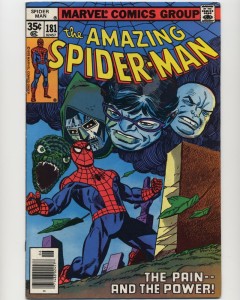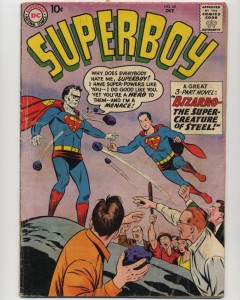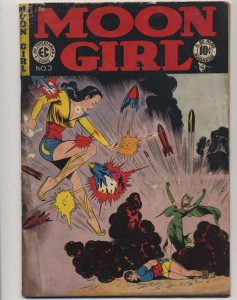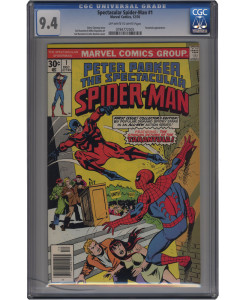Comic Book Grading
Comic book grading is the process of determining the grade or condition of a book, which directly influences its value. As with grading all collectibles, there is a degree of subjectivity as there are many factors to consider and all of them must be weighed to determine an overall grade. Different people may place different weight on each factor and thus, may grade the book differently than others. This is not to say that one person’s opinion of a grade is right while another’s is wrong but that they have differing opinions. In fact, it is often best to gather multiple opinions and average them to a final grade.
When shopping, it is an excellent idea to learn about comic book grading so that you can determine a book’s grade for yourself. This should give you peace of mind to know that you are getting a good value if your grade agrees with the seller’s. Most reputable dealers will strive to grade accurately or even a bit conservative in order to satisfy their customers. Dealers that exaggerate grades are likely trying to sell at inflated prices.
COMIC BOOK GRADING SCALE
There are eight major grades in the comic book grading scale. In descending order:
- Mint (MT)
- Near Mint (NM)
- Very Fine (VF)
- Fine (FN)
- Very Good (VG)
- Good (GD)
- Fair (FA)
- Poor (PO)
This comic book grading scale has been used for several decades, during which time the scale has been expanded to more accurately describe a book’s condition. First, is the use of a forward slash (/) to denote a book as being between grades. For example, “Fine / Very Fine” (or abbreviated “FN/VF”) denotes that book is graded between “Fine” and “Very Fine.”
Next is the use of plus (+) and minus (-) to denote that a book is slightly above or below a grade. Therefore the comic book grading scale is more refined now so that a “Fine+” is better than a “Fine,” a “Fine / Very Fine” is better than a “Fine+,” a “Very Fine -” is better than a “Fine / Very Fine”, a “Very Fine” is better than that and so forth.
Finally, a 10-point scale has been applied to give us the most modern system of comic book grading:
- 10.0 Gem Mint
- 9.9 Mint
- 9.8 Near Mint / Mint
- 9.6 Near Mint+
- 9.4 Near Mint
- 9.2 Near Mint-
- 9.0 Very Fine / Near Mint
- 8.5 Very Fine+
- 8.0 Very Fine
- 7.5 Very Fine-
- 7.0 Fine / Very Fine
- 6.5 Fine+
- 6.0 Fine
- 5.5 Fine-
- 5.0 Very Good / Fine
- 4.5 Very Good+
- 4.0 Very Good
- 3.5 Very Good-
- 3.0 Good / Very Good
- 2.5 Good+
- 2.0 Good
- 1.8 Good-
- 1.5 Fair / Good
- 1.0 Fair
- 0.5 Poor
This 10-point comic book grading scale is widely used now and you will often see people grade by simply putting the number value on the book with the classic descriptive grade. It is not the practice, however, to use numbers other than those in this scale so you wouldn’t see a book graded “6.3”. It is either a 6.0 or a 6.5.
COMIC BOOK VIEWING
In order to properly view a book, you need to view it outside of the bag and you will use several of your senses (not just sight, but touch and smell). You also need good lighting such as a desk lamp.
When handling a book, you need to take some precautions. First, be sure your hands are clean and dry. Some people prefer to use cotton gloves, which is fine. The main thing you need to do here is prevent dirt, oil or substances that be on your hands from getting on the book.
Most books are bagged to protect the book and the bag is usually secured with a piece of tape. It is best to completely remove the tape from the bag and place it somewhere where the book has no chance of coming in contact with it. Accidentally allowing the tape to come in contact with the book may result in damage, possibly as severe as a tear.
Make sure you have a clean, dry surface that is free of anything that could damage the book. One of the most common mistakes is having a drink or food nearby that could spill or drip on the book, causing a stain.
When viewing the book, use the desk lamp so you can clearly see everything. First, move the book around under the light to view the cover (including the back). You should be able to gather an opinion about the gloss of the cover by how the light reflects on it. Does it look completely new? Books with wear have lost some or all of their gloss and the degree of gloss remaining is one of the main factors in grading.
Moving the book at different angles under the light not only allows you to view the gloss, but also look for defects. You will be able to see light creases or folds, stains, dimples or other types of damage to the cover. Often minor defects such as a light crease where the paper has not been broken may be difficult to see without a good light, especially inside a bag.
Inspect the edges of the cover, including the corners. In high grade books, it is the corners that first see wear and so their sharpness may be what differentiates it from a “Near Mint” to a “Mint” grade.
Examine the spine very closely as it is the next spot that typically shows wear. Look very closely at the staples. Books that have seen water damage or just even some humidity may have staples that are corroding and causing the paper to turn color. You will also be looking for tears or even separation of the cover or pages from the staple.
As you open the book, be especially careful if you know you are dealing with one that is old and potentially brittle, or if you fear the staples are not firm. It is very easy to separate the cover from a staple if it is almost there already. Be aware that staples are often misaligned which makes it a lot easier to cause damage as either the front or back cover will pull on the staple.
Inspect the staple areas as good as you can from the inside to determine if they are nice and firm, pulled or even completely separated from the cover or any of the pages. Also check to see if the staples are original – they should be flat on the inside of the book rather than crimped like most staplers you find in an home are. Staples are often added or replaced to reinforce a book that is falling apart.
Next, you need to evaluate the paper quality. Paper typically has sulfur or other substances that cause it to turn color as it ages. You will need to describe what the paper looks and feels like. High grade books will have white or off-white paper. From there, paper will be yellow or tan to brown in color. Very old paper may even be brittle but you typically should not see this unless you are dealing with Victorian Age books.
You should also take note of the paper’s smell. Does is smell fresh or musty? Water damaged books will have a very strong musty smell but you will likely see the stains long before you notice the smell.
The other thing you are doing with your nose is detecting the use of chemicals. Paper can be cleaned in order to make it look white and traces of the chemicals used such as bleach will still be present.
As you did with the book closed, make use of the light, viewing the book at different angles. Look not only for obvious problems such as writing, tears or creases, but also for ones that have been hidden like pencil writing that has been erased. You can detect this by seeing less dirt in the erased spot and even the indentation of the writing in the paper from how the light reflects. Again, moving the book under the light is the key to seeing this.
You should view each page to check for the these defects, as for any clipped coupons or completed forms / puzzles. Also, pay close attention to the center of the book where the staples are visible. As with the cover, the inside page could be separated from the staples.
It always amazes me at the conventions how quickly someone will arrive at an opinion of a grade simply by viewing the book in the bag, by looking solely at the cover and spine. While this is a major factor in grading, the old saying “don’t judge a book by its cover” definitely rings true. A complete and thorough viewing of a book in ideal conditions is the best way to properly evaluate and grade a book.
COMIC BOOK GRADING
I’ve seen a number of comic book grading guides that list out a lot of detail for each grade. While this can be very helpful, I’d encourage you to practice developing a quick opinion of a rough grade (or range of grades) first then either reward or discount the grade by applying each of the attributes you noticed about the book during its evaluation. For example, you may immediately have an opinion of a Silver Age book right after viewing it, thinking “that’s a nice Fine or maybe even a Very Fine”. Then, look at your detailed observations to help you decide if it is a 6.0, 6.5, 7.0, etc.
To help with this approach, here’s my take on what each grade looks like first with an overall description then some examples of the degree of attributes for each grade. Keep in mind this is by no means complete and you also need to learn to weigh all of the attributes together to arrive at a final grade.
Mint
As the name of the implies, this is a perfect or near perfect book. It is as if it was printed yesterday and is completely without damage. It will have high gloss with very fresh looking (and smelling) ink. It is actually quite rare to describe any book from the Silver Age or earlier in this grade, simply due to the natural degradation of ink and paper.
Near Mint
A book in this grade should also look near perfect at a glance but may have very subtle defects such as corners that are not perfectly square or printing that is slightly misaligned or very slight off-white pages. It may actually take an experienced professional to tell the difference between a “Near Mint” and “Mint” book. Books that are “Near Mint” will simply have no problems that are so noticeable that you will see them right away. It will take a close examination and any defects present will be very minor and difficult to notice.
- The cover will be glossy and new.
- The pages will be white or nearly white and will feel supple and like new.
- The spine will be firm and flat; Any stress marks will be very minor and difficult to see.
- Date stamps and written dates are acceptable providing they are not obtrusive.
Very Fine


A book in this grade may not look like it was just printed but will definitely be a very attractive and obviously well taken care of book. It should simply scream to you, “I’m a great looking book.”
- The cover will have minor wear but will still have a lot of gloss and should be free of dirt.
- The pages can be off-white to even slightly yellow but should still be attractive and should still feel nice.
- The spine may have some stress marks but will still be firm and primarily flat.
- A small fold or crease (1/4″), tiny indentations or a slight bend is acceptable but must not be objectionable.
Often the degree of any small defects will make the difference between a VF or a VF+, for example. If upon examining the book, you have the opinion that it is really nice and close to a NM, then you are probably thinking of a range of grades from VF+ to NM-. Judging the severity of each of minor defect should help you decide if it is 8.5, 9.0 or a 9.2. Likewise, if “Fine” crosses your mind but are thinking it is close to “Very Fine,” then you are likely in the 6.5 to 7.5 range.
Fine


A book in this grade should be attractive and still very desirable to a collector. It may have some defect but the book should still have great eye appeal. This means the defects should be few, not very severe and inconspicuous. It can have one major defect that doesn’t negatively impact the eye appeal. For example, it could have a small tear provided it is difficult to see. If the tear is obvious and impacts the design and appeal of the cover, for example, it must be downgraded. Overall, a Fine book is going to look appealing.
- The cover can show some wear but should still have enough gloss and little enough dirt to be very attractive. It may have minor tears or creases/folds but shouldn’t have so many as to detract from its beauty.
- The pages may no longer be off-white – they be yellowish or light tan but still not showing too much age.
- The spine may have some visible stress lines or possibly a mild roll as long is it doesn’t misalign the book too much. The cover can be loose from one staple but not both.
- Any major defects must be limited and mustn’t impact the book’s eye appeal. This can mean the difference between a surface tear where some of the interior paper of the cover is visible and a clean one where you can barely tell there is a tear until you open the book. A book that would otherwise grade VF may have been downgraded due to a defect like a spine split, tear or very inconspicuous writing.
Very Good


A book in this grade will be more obvious that it is well read due to multiple problems. But it will still be fairly good looking to a collector, especially someone that is collecting an expensive, older book that may be hard to find in this grade. The problems will not be so severe to make you focus on them. For example, a spine roll shouldn’t make the whole book look crooked. Water damage, if present should barely be noticeable. If a piece is missing out of the cover, it shouldn’t be more than 1/4″ in size and should be somewhat inconspicuous. In short, major defects are acceptable but still need to be limited and not distracting.
- The cover will show definite wear and will have very little or no gloss left. There may be some soil or stains but not too heavy. There may be multiple or even a couple of major creases or a small piece missing but overall, the cover should still look attractive and complete.
- The pages may be yellowish, tan or even light brown but should still feel okay to the touch. You should not feel fearful of causing further damage by handling the the pages. They shouldn’t have any major tears or writing. Minor tears are okay, but should be very few and only in the margin – they should not extend in to the frame of the page.
- The spine may be split a bit or detached from a one staple but the cover must still be attached.
- Major defects are acceptable provided they do not detract from your enjoyment of looking at the book and reading it.
Good


A book in this grade can still be somewhat attractive and collectible but will have problems that are more severe or numerous than with a Very Good, to the point where you are at least a little distracted by them. It may simply be that there is more wear and soil on it. It may have numerous creases or wrinkles to where it is distracting. There may be some less conspicuous writing on it. Very Good is where a lot of the picky collectors draw the line unless it is a very expensive book. The defects will simply be too numerous or too severe for them to look at. However, the book will still be intact with all its pages and completely readable.
- The cover will show a lot of wear and may have some creases or fair amount of soil.
- The pages may have some tears or a small pieces missing but the book must still be readable. This means a piece missing mustn’t interrupt the story, no pages can be missing and the pages cannot be too fragile to turn.
- The spine may not be flat and could be a bit limp or have a roll.
Fair

A book in this grade now has problems that are more a little distracting. The problems will likely be a focus, drawing your attention away from at least some of the beauty of the book. Overall it will be quite worn and ragged, though still all there.
- The cover may have a lot problems including heavy folds and even a large chunk missing. It may even be detached from the staples.
- The pages will be fairly poor in quality, whether it is poor paper quality, or simply worn and aged with soiling, staining and chunks missing. A coupon clipped out is acceptable but not a panel.
- The spine my be completely split.
Poor
The name of this grade says it all. The problems with a book in this grade can be so severe that it may no longer have any collector value. Some of the cover or even some of the pages may be missing. There may be heavy stains, mildew or other problems that prevent one from enjoying the book to any degree.


My brother-in-law bought a box full of old comics, mostly 80’s Marvel stuff, st a yard sale. I would guess most to be fair to good condition, but wherever they were stored left them all smelling like oil and gas. How would that type of smell effect the value? It’s pretty noticeable.
Odor is definitely a factor in grading. A high grade comic book will not only look and feel new, but smell new with relatively fresh smelling paper. Books smelling like oil and gas will definitely be a turnoff for collectors and will negatively impact the grade. It’s tough to say what they would grade exactly without seeing them and evaluating their other attributes.
The pictures shown as examples were very helpful to understanding the elements involved in grading comic books. Thanks.
What effect on condition would a roll, not a crease, that shows through the whole comic have on the grading. The comic is in otherwise near mint condition.
A roll is significant sign of wear. It’s tough to say how much of an impact it would have without seeing the book. A good barometer is to simply think of how desirable it is to you as a collector. If you rate on a scale of 10 based on that approach and think it’s a 5, then you are probably looking at something in the Very Good to Fine range.
Great information and the pics really help